Everyone knows the tiger, the panda, the blue whale, but what about the other five to thirty million species estimated to inhabit our Earth? Many of these marvelous, stunning, and rare species have received little attention from the media, conservation groups, and the public. This series is an attempt to give these ‘forgotten species‘ some well-deserved attention.
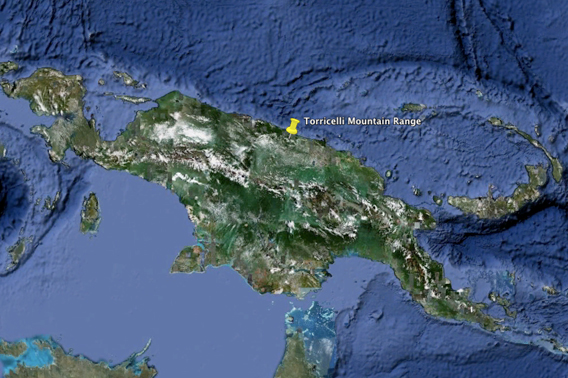
Torricelli Mountain Range on the island of New Guinea, home to the Critically Endangered Tenkile tree kangaroo. Image courtesy of Google Earth.
With their long snout, furry body, soft eyes, and, at times, upright stance, tree kangaroos often remind me of the muppets. Of course, if there were any fairness in the world, the muppets would remind me of tree kangaroos, since kangaroos, or macropods, have inhabited the Earth for at least 5 million years longer than Jim Henson’s muppets. But as a child of the 1980s, I knew about muppets well before tree kangaroos, which play second fiddle in the public imagination to their bigger, boxing cousins. This is perhaps surprising, as tree kangaroos possess three characteristics that should make them immensely popular: they are mammals, they are monkey-like (and who doesn’t like monkeys?), and they are desperately ‘cute’. The lack of general public knowledge about the 14 trees kangaroo species—and subsequent dearth of conservation attention—means that, yes, even adorable monkey and muppet-like mammals can be overlooked, bypassed, forgotten. Yet if the arboreal marsupials aren’t to vanish, this will have to change.
Not only are tree kangaroos ridiculously endearing, but, according to tree kangaroo expert Jim Thomas, they have special adaptations that separate them from their larger, more popular cousins.
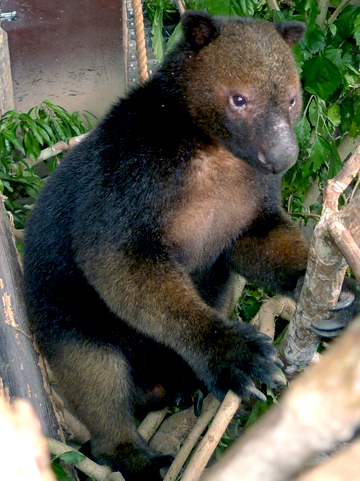 A captive Tenkile tree kangaroo. Photo courtesy of Jim Thomas. |
“Basically a tree kangaroo is a kangaroo that has adapted to life in the trees,” Thomas explained to mongabay.com. “Marsupial equivalent of a monkey—occupying the same niche. They are able to hop and walk bipedally—no other kangaroo can do the same. Tree kangaroos are also able to raise their arms above their head like a koala, but no other kangaroo can do this. Tree kangaroos are also considered more intelligent than other kangaroos.”
Unfortunately, over 20% of the world’s tree kangaroos are listed by the IUCN Red List as Critically Endangered, the direst category before extinction. These include both the dingiso and the golden-mantled tree kangaroo. But none of them are as imperiled as the Tenkile tree kangaroo, otherwise known as Scott’s tree kangaroo. Researchers estimate that only around 300 survive in a small area of Papua New Guinea’s Torricelli Mountain Range.
“I have seen three Tenkile in eight years, all from the wild. Magnificent animals, very placid and friendly and the most inquisitive tree kangaroo I’ve come across. Tenkile are large, black and have a distinctive smell,” says Thomas, who is the director of the Tenkile Conservation Alliance (TCA), the world’s only organization devoted to saving this species from vanishing off the face of the Earth.
As such, TCA has undertaken a herculean task. First, they had to tackle the problem of locals hunting the species. To date a moratorium has worked, allowing the Tenkile population to double from a nadir of 140 animals in 2004. But new threats are on the horizon, not just for the Tenkile tree kangaroo, but for all of Papua New Guineas’ forests and species.
 A captive Tenkile tree kangaroo. Photo courtesy of Jim Thomas. |
“Now logging and oil palm pose a threat to Tenkile. TCA is working hard to keep these threats out of the Torricelli’s [Mountain Range],” says Thomas.
Perhaps the fact that most of the world’s tree kangaroos live on the island of New Guinea is one explanation why these arboreal real-life muppets have received little attention from the outside world. New Guinea has largely been seen as a wild frontier, a land still untouched by the modern world. This however, as Thomas points out, is no longer true: palm oil, logging, mining and other large-scale industries are moving voraciously into the Papua New Guinean and the Indonesian parts of the island. These industries arrive with massive pressure for industrial development and cash-in-hand to back it up.
Despite this, the world’s big conservation organizations are largely ignoring Papua New Guinea, risking countless species, vast forests, and local people. Communities are seeing traditional land handed over to foreign corporations without local consent or even prior knowledge. If nothing is done, in a decade or two Papua New Guinea may resemble parts of Indonesia: vast areas of plantations and cleared forest; a people still impoverished but now without the forest resources on which they depended for millennia; and wildlife only hanging-on in a few parks, which are continually under siege by illegal logging.
What to do? In the case of TCA they are doing what they can for the Tenkile by pushing for its habitat to be turned into a protected area.
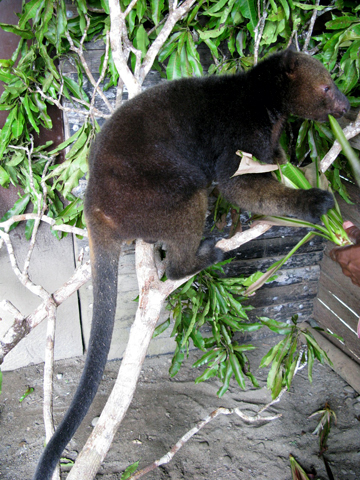 A captive Tenkile tree kangaroo. Photo courtesy of Jim Thomas. |
“TCA is establishing the Torricellis as a Conservation Area, and will hopefully have the area gazetted by Papua New Guinea government. The Torricelli’s, through TCA, is now recognized by government as a priority area for conservation—which is a huge step,” says Thomas.
TCA is also working to bring better lives to locals by providing environmental education and supplying water tanks to 40 villages in the Tenkile and the golden-mantled tree kangaroo habitats. A project on the horizon includes a pilot program for carbon trading, a way to bring in funds without clearing forests.
“More work and funding is required to keep up the momentum and outcomes becoming significant achievements. Tremendous support is present and this is unparalleled to anywhere else in Papua New Guinea,” Thomas says, but the “public can help by spreading the word on TCA and consider volunteering.”
For Thomas a highlight of his work with TCA was researching a male Tenkile tree kangaroo in captivity. Dubbed ‘Neingol’, the tree kangaroo was released back into the wild after six weeks.

|
“I took a team into the mountains to release Neingol. It took two days to reach the area where Neingol was caught. I released him carefully and he was at first reluctant to leave his small wire cage […] He stayed close for 30 minutes or so—I was able to pat him and move freely. All of a sudden his nose went to the air, he smelled and he ran off along the ground,” Thomas says, adding that, “Seeing a wild caught animal do well in captivity and then releasing it back into the wild was a real highlight of my career and something I will never forget.”
For Jim Thomas, his time with the Tenkile was unforgettable. But since most of us will never see a wild Tenkile, the question is will this species—and the conservation efforts that are currently sustaining it—be forgotten?
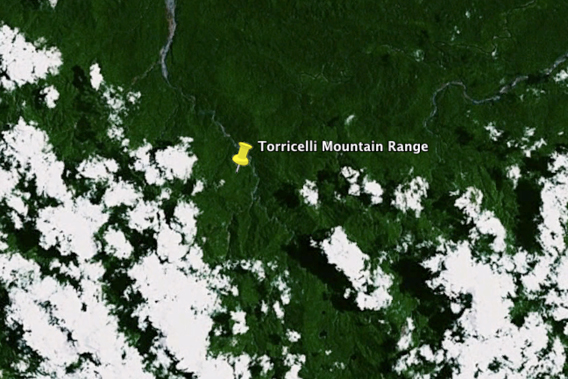
A closer look at the Torricelli Mountain Range, bathed in clouds. Image courtesy of Google Earth.
To discover more of the world’s forgotten species: Click Here.
Related articles
Scientists urge Papua New Guinea to declare moratorium on massive forest clearing
(04/19/2011) Forests spanning an area larger than Costa Rica—5.6 million hectares (13.8 million acres)—have been handed out by the Papua New Guinea government to foreign corporations, largely for logging. Granted under government agreements known as Special Agricultural and Business Leases (SABLs), the land leases circumvent the nation’s strong laws pertaining to communal land ownership. Now, the Association for Tropical Biology and Conservation (ATBC), the world’s largest professional society devoted to studying and conserving tropical forests, is urging the Papua New Guinea government to declare a moratorium on SABLs.
5 million hectares of Papua New Guinea forests handed to foreign corporations
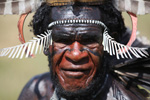
(03/23/2011) During a meeting in March 2011 twenty-six experts—from biologists to social scientists to NGO staff—crafted a statement calling on the Papua New Guinea government to stop granting Special Agricultural and Business Leases. According to the group, these leases, or SABLs as they are know, circumvent Papua New Guinea’s strong community land rights laws and imperil some of the world’s most intact rainforests. To date 5.6 million hectares (13.8 million acres) of forest have been leased under SABLs, an area larger than all of Costa Rica. “Papua New Guinea is among the most biologically and culturally diverse nations on Earth. [The country’s] remarkable diversity of cultural groups rely intimately on their traditional lands and forests in order to meet their needs for farming plots, forest goods, wild game, traditional and religious sites, and many other goods and services,” reads the statement, dubbed the Cairns Declaration. However, according to the declaration all of this is threatened by the Papua New Guinea government using SABLs to grant large sections of land without going through the proper channels.
Stopping export logging, oil palm expansion in PNG in 2012 would cost $1.8b, says economist
(03/07/2011) Stopping logging for timber export and conversion of forest for oil palm plantations would cost Papua New Guinea roughly $2.8 billion dollars from 2012 to 2025, but would significantly reduce the country’s greenhouse gas emissions, according to a new analysis published by an economist from the University of Queensland.
Foreign corporations devastating Papua New Guinea rainforests

(10/21/2010) A letter in Nature from seven top scientists warns that Papua New Guinea’s accessible forest will be lost or heavily logged in just ten to twenty years if swift action isn’t taken. A potent mix of poor governance, corruption, and corporate disregard is leading to the rapid loss of Papua New Guinea’s much-heralded rainforests, home to a vast array of species found no-where else in the world. “Papua New Guinea has some of the world’s most biologically and culturally rich forests, and they’re vanishing before our eyes,” author William Laurance of James Cook University in Cairns, Australia, said in a statement.
Photos: 200 new species discovered in 60-day expedition in New Guinea

(10/06/2010) A 2009 expedition to Papua New Guinea proves once again that the island-nation is as diverse in life as it is in human cultures. It took researchers with Conservation International (CI) and the local Institute for Biological Research (IBR) just two months to uncover a startling 200 new species: averaging more than 3 a day in the remote Nakanai Mountains and Muller Range rising from the island of New Britain, a part of Papua New Guinea. Half of the new species were spiders, but the team also found two new mammals, nine new plants, two dozen frogs, and multitude of insects. Most surprising was the discovery of at least two species so unique that they are likely to be assigned their own genus.
Papua New Guinea strips communal land rights protections, opening door to big business

(06/30/2010) On May 28th the parliament in Papua New Guinea passed a sweeping amendment that protects resource corporations from any litigation related to environmental destruction, labor laws, and landowner abuse. All issues related to the environment would now be decided by the government with no possibility of later lawsuits. Uniquely in the world, over 90 percent of land in Papua New Guinea is owned by clan or communally, not be the government. However this new amendment drastically undercuts Papua New Guinea’s landowners from taking legislative action before or after environmental damage is done. Essentially it places all environmental safeguards with the Environment and Conservation Minister.
Indonesia to target New Guinea for agricultural expansion
(02/22/2010) Indonesia will target its last frontier — its territory on New Guinea — as it seeks to become a major agricultural exporter, reports the AFP.
Asia’s biggest logging company accused of bribery, violence in Papua New Guinea
(02/08/2010) A local organization in Papua New Guinea, known as Asples Madang, is fighting against one of the region’s biggest industrial loggers, Rimbunan Hijau (RH) chaired by billionare Tiong Hiew King. Aspeles Madang has accused Malaysian company, RH, of acquiring land illegally and of using brute force and bribery in its dealing with locals.
Palm oil developers in Papua New Guinea accused of deception in dealing with communities

(09/25/2009) Papua New Guinea, the independent eastern half of the world’s second largest island (New Guinea), houses one of the planet’s last frontier forests. These forests support a wealth of plants and animals as well as the Earth’s most diverse assemblage of cultures—some 830 languages are spoken in Papua New Guinea (PNG), representing more than 12 percent of the world’s 6,900. But PNG’s forests are fast-changing. Between 1972 and 2002 PNG lost more than 5 million hectares of forest, trailing only Brazil and Indonesia among tropical countries. Forest loss has been primarily a consequence of industrial logging and subsistence agriculture, but large-scale agroindustry—especially development of oil palm plantations—has emerged as an important new driver of land use change. Dozens of international companies have set up operations in the country over the past decade, including Cargill, an agribusiness giant based in Minneapolis. While Cargill says it is committed to sustainable and responsible palm oil production across its three plantations in PNG, the firm has been targeted by local and international NGOs, which claim it has polluted rivers and deceived local communities into signing agreements they do not understand. Some landowners say they are receiving few of the benefits oil palm promised to deliver, while losing their independence—they are now reliant on an export-oriented crop they can’t eat. Opposition to further oil palm expansion is now growing, especially in Oro Provice, where Cargill’s plantations are based.
World’s rarest tree kangaroo gets help from those who once hunted it
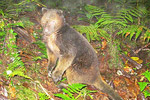
(08/17/2009) The world’s rarest tree kangaroo is in the midst of a comeback in a remote part of Papua New Guinea. On the brink of extinction in 2001 with a population estimated at fewer than 100 individuals, Scott’s Tree Kangaroo (Dendrolagus scottae), or the tenkile, is recovering, thanks to the efforts of the Tenkile Conservation Alliance to motivate local communities to reduce hunting and respect critical forest habitat. The tenkile Conservation Alliance, led by Australians Jim and Jean Thomas, works to provide alternative sources of protein and raise environmental awareness among local communities.













